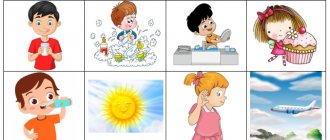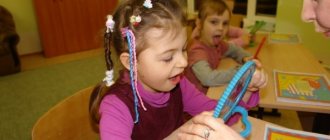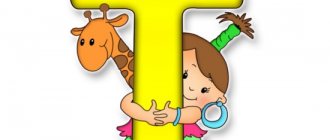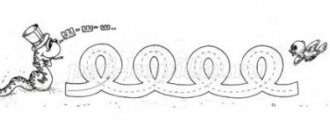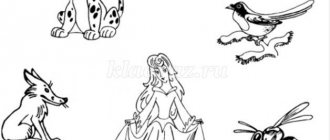Reasons for incorrect sound pronunciation
There are several reasons why a baby may not be able to make sounds:
- Short frenulum of the tongue - you will have to cut it, because it does not allow the tongue to rise up, which is necessary for the pronunciation of sibilants;
- High narrow hard palate;
- Abnormal structure of teeth and jaws - gaps between teeth, cleft palate and upper lip;
- Features of the bite: open, deep with protrusion.
In these cases, consultation with an orthodontist is necessary. But in most cases, children simply do not understand how to pronounce the sound correctly or copy the speech of other children, for example in kindergarten. In this case, speech therapy exercises “w” and gymnastics - articulation and breathing - will help.
Incorrect pronunciation of sound: types of sibilant sigmatism
Sometimes parents of a child who has problems with sound pronunciation turn to a speech therapist late for help. Or they even think that the baby has no problems with speech, due to the fact that they do not always know how this or that sound should be reproduced correctly. Each sound has its own articulatory position. By ear, it may seem that the child seems to pronounce it (doesn’t miss it or replace it, just “F” is heard), but at the same time he doesn’t always articulate it correctly.
The work is carried out individually, depending on the characteristics of the violation. There are several types of hissing sigmatism, characterized by incorrect position of the organs of the speech apparatus:
- Lower (the sound is softened).
- Rear-lingual (in this case, the position of the articulatory organs is as with the sounds G, X; this leads to the fact that the sound Z is pronounced noisily).
- Buccal (in this case, the tongue is motionless, the cheeks are puffed out, the teeth are closed, and a dull, booming sound is formed).
Articulation gymnastics for making the sound “zh”
Do the exercises daily, preferably sitting in front of a mirror. Conducted in a playful manner. First, the child is shown the correct articulation of sound:
- lips are rounded and pushed forward;
- we close or bring our teeth together;
- we raise the tip of the tongue to the alveoli, but do not press it against them;
- We press the side walls of the tongue against the upper molars;
- As you exhale, a warm air stream should pass through the middle of your tongue.
The sound “zh” is sonorous and is pronounced with a voice. To learn this, you need to perform this set of exercises.
First (initial) exercise. Instructions: smile, show your teeth, put them on top of each other like a fence. Say “and” to yourself and count to 10.
Exercise No. 2. Take the starting position, stretch your lips forward, round them, as if you want to say “oh,” count to 10.
Exercise No. 3. Spread your tongue below, resting the tip against your lower teeth. Smile, open and close your mouth. Repeat up to 10 times.
Exercise No. 4. Flatten your tongue and don't move it. He should not touch his lower lip or tremble. The lower teeth are exposed. Count to 10.
Exercise No. 5. Open your mouth so your teeth are visible. Stroke the roof of your mouth with the tip of your tongue - back and forth.
Exercise No. 6. Spread your tongue and place it on your lower lip. Lick your upper lip from top to bottom, while moving your tongue behind your teeth. Don't move your jaw.
Exercise No. 7. Smile and open your mouth slightly, spread your tongue and place its tip on your upper lip. Press the side surfaces of the tongue so that a groove is formed in the middle. Make a movement as if you are blowing fluff from the tip of your nose. Make sure the air goes down the middle of your tongue.
When articulating the sound Zh
- lips are rounded and slightly pushed forward;
- teeth are brought together;
- the wide tip of the tongue is raised to the alveoli or to the anterior edge of the hard palate and forms a gap with it; the middle part of the back of the tongue drops, but the edges of the tongue are pressed against the lateral teeth; the back of the back of the tongue rises and pulls back;
- in the middle of the tongue there is a warm air stream, which is easily felt by the palm of the hand brought to the mouth;
- the soft palate is raised and pressed against the back wall of the pharynx, closing the passage into the nasal cavity; the air stream goes through the mouth;
- the vocal folds are tense, vibrate and give voice.
After attempting to pronounce the sound z, the speech therapist or teacher discusses the quality of the sound. If there is a discrepancy with the normalized sound, the child discusses exactly which link the error was made and the problematic operation is found on the diagram.
Speech therapy breathing exercises
With correct articulation of the sound “zh”, a warm air stream passes through the middle of the tongue when the baby exhales air. If the pronunciation is incorrect, this stream does not exist. Therefore, the goal of gymnastics is to teach this to a child.
When performing exercises, you need to watch your body: your shoulders are motionless, your chest does not rise much when you inhale, and when you exhale, it falls moderately. You need to inhale through your mouth, the inhalation is soft and short, the exhalation is slow and smooth. After inhaling, we immediately begin to speak (but while exhaling).
Here are breathing exercises.
Exercise No. 1. Children are asked to blow a paper snowflake off their palm. Whoever flies further, well done.
Exercise No. 2. Take a strong, intermittent exhale, as if extinguishing a candle, and at the same time say “fuuuu.”
Exercise No. 3. Place a bottle with a narrow neck to your lower lip and blow. There should be some noise.
Exercise No. 4. Smile, hide the tip of your tongue behind your lower teeth, and lift the back of your tongue up. Exhale.
Prepared by a teacher-speech therapist
Borisova Elena Ivanovna
MBDOU "Kindergarten No. 73 "Polyanka" of the city of Cheboksary, Chuvash Republic
Integration of educational areas: “Cognitive development”, “Speech development”, “Physical development”, “Social and communicative development”, “Artistic and aesthetic development”.
Purpose of the lesson : automation of the sound “F” in straight syllables and in words with straight syllables.
Correctional educational tasks:
1. Educational area “Speech development”
- practice forming the plural of nouns;
- develop skills in agreeing nouns with cardinal numerals;
- automate the sound “Zh” in syllables and words.
2. Educational area “Cognitive development”
- activate objects with the sound “F” in speech;
- clarify the correct articulation of the sound “Zh”.
Correction and development tasks:
1. Educational area “Speech development”
- improve the psychological basis of speech: auditory, visual attention and memory;
- develop phonemic awareness;
- form a long, smooth exhalation;
- develop articulatory and general motor skills.
2. Educational area “Physical development”
- maintaining and promoting health;
- formation of kinesthetic and tactile sensations;
- Accumulation and enrichment of the child’s motor experience.
3. Educational area “Social and communicative development”
- improve the mechanisms of voluntary regulation of behavior and activity
Correctional and educational tasks:
Educational field "Social and communicative development"
- develop skills of initiative and independence;
- form a positive attitude towards the lesson.
Equipment: soft toy hippopotamus Zhuzha, symbol pictures, object pictures, small toys with the sound “Zh” in their names, mirror.
Previous work
- organization of didactic “Catch the sound”, “One is many”, “One-two-five”, “Say the opposite”, “Say a word”, “Where the sound is hidden”, “Say kindly”;
- formation of articulatory skills necessary for the correct pronunciation of the sound “F”;
- practicing fine motor skills exercises;
- practicing reference sounds;
- setting the sound “Zh”
Methodical techniques:
- Organizing time;
- gaming motivation;
- articulation gymnastics;
- breathing exercises;
- Game Game “Catch the Sound”;
- Game “Where the sound was hidden”;
- Game “Name it kindly”;
- Game “Say the opposite”;
- Game "One-two-five";
- Game "Guess";
- Incentives.
Progress of the lesson
Organizing time.
Speech therapist: Hello, my friend. Today the hippopotamus Zhuzha came to visit us. Say hello to him. Repeat his name. He wants to play different games with you. Do you want to play with him? (Child: yes I want).
- Articulation gymnastics.
Speech therapist : Zhuzha will show you pictures-symbols, and you will show him how they can be depicted using the tongue and lips, okay? (“Smile”, “Fence”, “Swing”, “Painter”, “Turkey”.
- Characteristics and articulation of the sound “Zh”.
Speech therapist : What sound does our hippo’s name begin with? (with the sound “Zh”).
- And when we pronounce the sound “Zh”, what position are our lips in? (lips rounded) where is our tongue? (tongue “Cup” behind the upper teeth, the side edges are pressed against the molars), and what position are the teeth in? (the teeth are close to each other, there is a small distance between them).
— Do we pronounce this sound with difficulty or easily? Can it be sung or not? (we pronounce it with difficulty, but we can’t sing it?). So what is this sound, a vowel or a consonant? (this sound is a consonant). Is he voiced or deaf? (voiced). Hard or soft? (solid).
- How did you determine that this sound is ringing (If you close your ears with your hands and pronounce the sound “Zh”, then we will hear the sound in our ears).
- Well done, now Zhuzha has learned that the sound “Zh” is consonant, sonorous, and hard.
- Game: “Catch the Sound” - development of phonemic awareness
Speech therapist: Zhuzha and I will pronounce different syllables and words, if you hear the sound “Zh”, press all your fingers on the sand (zha, zhu, po, zho, ly, zhu, so, beetle, poppy, spoon, magazine, zhak, table, garage, waiter, catfish, vegetables, belly, puddle, bee).
— Well done.
- Game: “Pictures - Cobwebs” - development of long-term memory
Speech therapist : Hippo Zhuzha has prepared a surprise for you. He brought pictures - cobwebs. Remember all the pictures that are depicted on this “web”, remember in what sequence they are located (1 minute is given for memorization). (The web shows: toad, beetle, flag, hedgehog, knife)
“I remember, now fold the web and put it in your pocket.”
- Game: “Repeat after us” - automation in syllables and words
Staging the sound “zh” step by step
The sound production lesson takes place in 3 stages. It is carried out in the form of a game in a group of 4 – 5 children.
At the first stage, children are shown how the tongue should be positioned when pronouncing a sound.
The second stage of sound production
The speech therapist finds out how the child pronounces the sound “zh” and what errors in articulation he makes. At the same stage, articulation and breathing exercises are carried out and they begin to practice the sound “zh” (provided that the students pronounce “sh”). Most children begin to say it by imitation - this is the simplest method of making the sound “zh”.
Exercise "Bug". The children are shown a picture of a beetle and asked to remember how the bugs flew and buzzed in the summer. Then they ask you to repeat this sound.
Exercise "Ball". Children are asked to imitate the hissing sound when the balloon bursts. And then - say the same thing, only with a voice.
Exercise "Voice". Students are asked to repeat the hissing sound (the “sh” sound) and at this time place their hands on their necks. They ask: “What does the little voice do? Is he sleeping or singing? The children will answer that he is sleeping. Then they are asked to say “sh” with the voice - they will note that now the “voice is singing” - a vibration has appeared in the neck.
By the same analogy as in the “Bug” exercise, the games “Fly in the Web” and “Bees Collect Flowers” are played. During the process, it is important to control correct articulation.
These speech therapy exercises can be done with the baby and at home to consolidate the skill.
The third stage of the lesson is sound production
Children learn to correctly pronounce the sound “zh” in words and phrases. The main condition is that they must clearly and unmistakably speak the sound in isolation. To do this, conduct an exercise with pictures.
First, the teacher selects pairs of pictures - subject and plot. On the object ones, an object is drawn, the name of which contains the sound “zh”. Words in which it comes at the end or before voiceless consonants are not suitable. The plot pictures depict situations in which the object shown in the first pictures is missing. For example, a girl with paper (scissors), a boy on a slide (skis), a house in flames (fireman).
Exercise No. 1. The teacher shows several plot illustrations and asks the students who is missing what. They call.
Exercise No. 2. Children are shown object pictures and asked to name what is drawn on them. They call.
Exercise No. 3. The teacher asks who needs the depicted object. The children answer, for example: “The girl needs scissors to cut paper.”
This is how all plot pictures go. When performing speech therapy exercises on the sound “zh”, children should highlight it in their voice - speak a little longer than other sounds.
The final stage of correction is automation
The production of the sound “zh” is gradually completed by automation. The goal is to teach children to pronounce sounds correctly in isolation, in syllables, words and phrases.
Carry out in several stages:
- Isolated sound pronunciation. Imitation of the buzzing of a bumblebee, bee, beetle, spinning top;
- Pronunciation in syllables. Here is a list of syllables for speech therapy exercises for the sound “zh”: “zha”, “zho”, “zhu”, “zhi”, “zhe”;
- Pronunciation in combinations of syllables. List of syllables in the speech therapy exercise letter “zh”: “zha-zha-zha”, “jo-jo-jo”, “zhu-zhu-zhu”, “zhi-zhi-zhi”, “zhe-zhe-zhe”, and then: “zha-zho-zhu”, “zhi-zhe-zha”, “zhu-zho-zhe”, “zhe-zha-zhe”, add one more syllable: “zhi-zha-zho-zhe-zhe” ", "zhu-zhu-zhu-zhi-zhe", "zhu-zha-zho-zhi-zhe";
- Pronunciation in words. The speech therapist selects words based on the syllables: “zha”, “zho”, “zhe”, “zhi”, “zhu”, “zhe”, as well as “zhd”, “zhg”. First, these syllables occur at the beginning of the word, then at the end, then in the middle;
- Pronunciation in words with consonant clusters. For example, trunk, friendship, clothes, diligent, scissors, southern;
- Pronunciation of words with two “w” sounds. Here is a list of words: thirst, buzz, yellow-skinned.
In all exercises, when pronouncing syllables and words in a voice, the sound “w” is emphasized.
They also play the game “Name it kindly” with children. They give a list of words, and students form a noun with a diminutive meaning. These words are: snow, hedgehog, boot, knife, haystack, beach, rain, iron.
They reinforce the skill by reading texts and tongue twisters in which the sound “w” is often found.
Speech hearing
Correct speech of a child is achieved through speech hearing. To pronounce sounds correctly, the child must clearly perceive them by ear.
Determine the location of sounds in a word: at the beginning, middle or end of the word. Hear whether a given sound is hissing or not.
Distinguish sounds against the background of similar sounds:
- In an isolated position
- In syllables
- In words
Expert opinion
Margarita Sergeevna S.
Speech pathologist and speech pathologist with 15 years of experience working in various speech correction centers with children of different ages.
With dysarthria, the production and automation of hissing sounds becomes more complicated and requires more time and individual training.
Stage II of work
(conducted as part of the lesson)
Subject . Clarifying the pronunciation of an existing sound or evoking it by imitation. Development of speech breathing, voice strength. Target . To achieve, whenever possible, from each child the correct, long, loud pronunciation of the sound zh. Previous work . The sound sh has been worked out, identical in articulation to the sound zh. Preparatory work . Clarify how the children of the group pronounce the sound z. Prepare a picture of a beetle.
Exercise “The beetle is buzzing”
Brief description The teacher or speech therapist shows the children a picture of a beetle and asks them to remember how in the summer the beetles flew and buzzed at the dacha (they pronounce the sound zhzh for a long time). The teacher draws the children's attention to the position of the lips (rounded and slightly pushed forward), the tongue (the wide tongue is raised towards the tubercles behind the upper teeth), and the presence of a warm air stream coming out of the mouth. Then the teacher says: “Let us remember how the air hissed when it came out of the bursting balloon... What did the voice do when we said the sound w? (“The voice slept, the house was quiet”). Let’s put our hand to the neck and say for a long time: “zhzh...” What is the little voice doing: sleeping or singing songs? (“A voice sings a song.”) Does he sing songs loudly or quietly?” (“The voice sings songs so loudly that the walls of the house shake.”) Then the teacher says that in addition to beetles, bees and flies can buzz, and invites the children to play bees.
Game "Bees Collect Honey"
Brief description Some of the children depict flowers. The teacher puts a wreath on each child’s head from the flowers that he depicts (for one - daisies, for another - cornflowers, etc.). The rest of the children portray bees that collect honey from flowers. The bees fly around the flowers and buzz: “zhzh..” At the teacher’s signal, they fly into the hive (fenced off area). Then the children change roles.
Game "Flies in the Web"
Brief description Some of the children depict a web. They form a circle. Other children, pretending to be flies, buzz: “zhzh...”, running in and out of the circle. At the teacher’s signals, the children depicting the web join hands, and the children in the circle stand in it, the web increases in size. The game continues until all the flies are caught.
Methodical instructions.
The game is best played with subgroups of four to five people. In order for children to correctly pronounce the sound z, it is necessary to monitor the correct position of the lips, tongue, and the presence of a straight exhaled stream of air. Remind you that when the wind rustled in the trees, it rustled quietly; and flies, bees, and beetles buzz loudly: when a sound is pronounced, the voice “sings a song.”
Note : These games can be played outside of class in order to consolidate the pronunciation of the isolated sound z.

